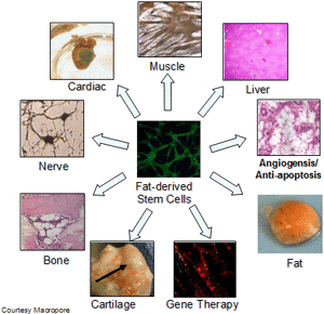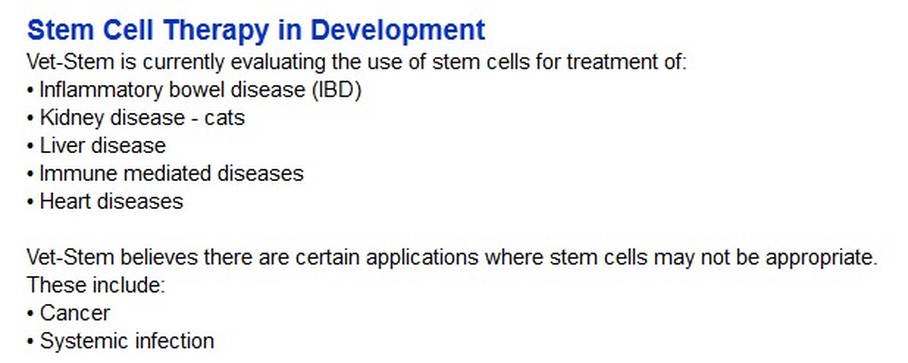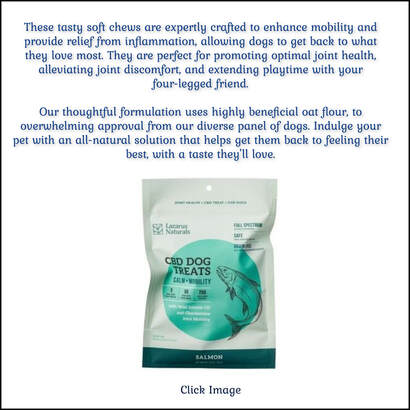What Can Be Treated with Vet-Stem Cells?
By Vet-Stem.com
• Arthritis in Dogs & Cats
• Joints, Tendons & Ligaments in Horses
What Results Have Dog Owners Reported?
• Greater than 80% of dogs with arthritis have improvedQuality of Life
• Here are outcome survey results for Older Dogs
• Here are outcome survey results for Younger Dogs
• Here are outcome survey results for Dogs on Pain Medication What Results Have Horse Owners Reported?
• Suspensory Ligament Injuries: 76% returned to Full Work - Prior Level
• Tendon Injuries: 77% returned to Full Work - Prior Level
• Joint Disease: 57% returned to Full Work - Prior Level
What is the Process?
Stem cells are processed from your animals own fat.
• Arthritis in Dogs & Cats
• Joints, Tendons & Ligaments in Horses
What Results Have Dog Owners Reported?
• Greater than 80% of dogs with arthritis have improvedQuality of Life
• Here are outcome survey results for Older Dogs
• Here are outcome survey results for Younger Dogs
• Here are outcome survey results for Dogs on Pain Medication What Results Have Horse Owners Reported?
• Suspensory Ligament Injuries: 76% returned to Full Work - Prior Level
• Tendon Injuries: 77% returned to Full Work - Prior Level
• Joint Disease: 57% returned to Full Work - Prior Level
What is the Process?
Stem cells are processed from your animals own fat.
What Do Stem Cells Do?
|
What is Vet-Stem Regenerative Medicine? Regenerative Medicine is a broad definition for innovative medical therapies that will enable the body to repair, replace, restore and regenerate damaged or diseased tissues.
Vet-Stem Regenerative Medicine uses a concentrated form of autologous adipose-derived adult stem cells to treat traumatic and degenerative diseases, including bowed tendons, ligament injuries, osteoarthritis, and osteochondral defects in horses, dogs and cats. Success in human clinical trials and animal models Despite its infancy, regenerative medicine is not new. Success in numerous animal models of disease and emerging success in human clinical trials for Crohn's fistulas and stroke, along with hundreds of ongoing clinical trials (See sidebar) support the rationale for stem cell use, and now success, in veterinary medicine. Vet-Stem collaborative and clinical research demonstrate positive results in treating horses with tendon and ligament injuries, osteochondral defects, and osteoarthritis.3-6 The first peer reviewed double-blinded multicenter study for adipose-derived stem cell therapy use in canine osteoarthritis of the hip showed significant improvement in all post treatment evaluation times for lameness, pain, and range of motion. Similar results have been obtained for canine elbows and stifles. Stem cells are multipotent and can differentiate into tendon, ligament, bone, cartilage, cardiac, nerve, muscle, blood vessels, fat, and liver tissue (see figure below). The stromal fraction that is harvested from adipose tissue is a heterogeneous mixture of regenerative cells (see below). |
|
Vet-Stem Technology: Summary
Vet-Stem Regenerative Cell Therapy is based on a clinical technology licensed from Artecel Inc. Original patents are from the University of Pittsburgh and Duke University. Rationale based on consistent therapeutic success in numerous animal models of disease (see sidebar) Adipose-derived stem cells (Vet-Stem Regenerative Cells: VSRC™) Autologous cell therapy Currently used in horses with bowed tendons, ligament injuries, and fractures, and in dogs with osteoarthritis More than 4,000 horses treated since 2003 More than 3,500 dogs treated since 2006 No systemic adverse events reported and < 0.5% local tissue reactions. Demonstrated efficacy with VSRC therapy in horses and dogs Cornell University double-blind, placebo controlled study Retrospective studies Case studies Double-blinded placebo controlled multicenter study Why use adipose-derived regenerative cells rather than regenerative cells derived from bone marrow? Adipose-derived regenerative cells are: Readily available source Can be collected in far greater concentrations than those from bone marrow Able to differentiate into multiple lineages implicating their potential in bone, cartilage, and cardiac repair (See figure above) Fractions isolated from adipose tissue contain a heterogeneous mixture of regenerative cells, including: Mesenchymal stem cells (MSCs) Endothelial progenitor cells Pericytes Immune cells Fibroblasts Other growth factor-secreting bioactive cells |
|
Differences in Regenerative Medicine compared to traditional medicine: Does not rely on a single target receptor or a single pathway for its action Regenerative cell mixture is delivered either directly to the traumatic wound (e.g.: tendonitis, desmitis, fracture) or are delivered systemically (e.g.: liver disease, renal disease) Regenerative cells can differentiate into many tissue types, induce repair, and stimulate regeneration Regenerative cells "communicate" with the cells of their local environment through paracrine and autocrine modalities, creating the optimal environment for natural healing Regenerative cells produce a variety of both secreted and cell surface substances that regulate tissue growth, integrity, and function. Mechanisms for success… Vet-Stem Regenerative Cell (VSRC™) therapy delivers a functionally diverse cell population able to communicate with other cells in their local environment. Until recently, differentiation was thought to be the primary function of regenerative cells. However, the functions of regenerative cells are now known to be much more diverse and are implicated in a highly integrated and complex network. VSRC therapy should be viewed as a complex, yet balanced, approach to a therapeutic goal. Unlike traditional medicine, in which one drug targets one receptor, Regenerative Medicine, including VSRC therapy, can be applied in a wide variety of traumatic and developmental diseases. Regenerative cell functions include: Anti-inflammatory/Immunomodulation: In general, in vitro studies demonstrate that MSCs limit inflammatory responses and promote anti-inflammatory pathways. When present in an inflammatory environment, data demonstrates that MSCs may alter the cytokine secretion profile of dendritic cell (DC) subsets and T-cell subsets causing a shift from a pro-inflammatory environment to an anti-inflammatory or tolerant environment. MSCs do not express MHC class II antigens or costimulatory molecules and they suppress T cell proliferation. MSC suppress mixed lymphocyte reactions and inhibits T cell proliferation induced by a third cell type or by mitogenic factors. MSC are able to control lethal graft versus host disease (GVHD) in mice after haploidentical hematopoietic transplantation. Trophic Support: Multiple studies demonstrate that MSCs secrete bioactive levels of cytokines and growth factors that that support angiogenesis, tissue remodeling, differentiation, and antiapoptotic events. MSCs secrete a number of angiogenesis-related cytokines such as: Vascular endothelial growth factor (VEGF) Hepatocyte growth factor (HGF) Basic fibroblast growth factor (bFGF) Granulocyte-macrophage colony stimulating factor (GM-CSF) Transforming growth factor – β |
|
Differentiation:
Adipose derived MSC studies demonstrate a diverse plasticity, including differentiation into adipo-, osteo-, chondro-, myo-, cardiomyo-, endothelial, hepato-, neuro-, epithelial and hematopoietic lineages, similar to that described for bone marrow derived MSC. These data are supported by in vivo experiments and functional studies that demonstrated the regenerative capacity of adipose-derived MSCs to repair damaged or diseased tissue via transplant engraftment and differentiation. Awad and colleagues reported significant improvements using autologous MSC delivery in a rabbit Achilles tendon repair model compared to cell-free collagen control rabbits. Nixon and colleagues demonstrated statistically significant improvement in histological repair of a collagenase-induced injury in the superficial digital flexor tendonitis in horses treated with autologous regenerative cells harvested from fat.5 In a caprine model of traumatic joint injury, MSCs delivered intra-articularly engrafted and repaired meniscal tissue, leading to a statistically significant reduction in the progression of osteoarthritis. Multiple studies demonstrate in vivo bone regeneration and repair in animal models. Bruder and colleagues demonstrated in two studies that MSCs could be used to repair a critical defect in a non-union fracture model in dogs. Cowan and colleagues demonstrated that MSCs heal a critical-size mouse calvarial defect in which there was increased bone formation and mineralization compared to controls. A human clinical case showed a dramatic regeneration of the calvarium in a young girl with severe traumatic damage. In a rodent cerebral infarct model, Jeong and colleagues demonstrated that infracted rats administered magnetically labeled MSC administered two weeks after the creation of an infarct experienced restoration of locomotor function compared to controls. Homing: Homing (chemotaxis) is an event by which a cell migrates from one area of the body to a distant site where it may be needed for a given physiological event. Homing is an important function of MSCs and other progenitor cells and one mechanism by which intravenous or parenteral administration of MSCs permits an auto-transplanted therapeutic cell to effectively target a specific area of pathology. |
|
Nilsson and colleagues demonstrated that labeled cells of bone lineage injected intravenously into mice can engraft, form bone, and give rise to osteocytes and bone lining cells detectable on the mouse femur.
Chen and colleagues performed peripheral intravenous experiments using a cerebral arterial occlusion model of stroke and demonstrated that labeled MSCs administered 24 hours and 7 days post-injury has demonstrated migration to the area of injury as well as a dramatic reduction in stoke infarct size. Revascularization: Adipose derived regenerative cells contain endothelial progenitor cells and MSCs that assist in angiogenesis and neovascularization by the secretion of cytokines, such as hepatic growth factor (HGF), vascular endothelial growth factor (VEGF), placental growth factor (PGF), transforming growth factor (TGFβ), fibroblast growth factor (FGF-2), and angiopoietin. Chen and colleagues examined the effect of intravenous administration of MSCs after cerebral arterial occlusion in the rat and demonstrated new capillary formation, increased vessel formation and increased VEGF (vascular endothelial growth factor) expression in the areas of the lesion. In an in vivo model of hindlimb eschemia, intravenous injection of MSC were associated with an increase in blood flow and capillary density and incorporation of the cells in the leg vasculature. Rehman and colleagues demonstrated that nude mice with ischemic hind limbs demonstrated marked perfusion improvement when treated with human MSC. |
|
Anti -Apoptosis:
Apoptosis is defined as a programmed cell death or “cell suicide”, an event that is genetically controlled. Under normal conditions, apoptosis determines the lifespan and coordinated removal of cells. Unlike necrosis, apoptotic cells are typically intact during their removal (phagocytosis). Rehman and colleagues demonstrated this effect in acutely injured tissue denied critical blood-flow resulting in ischemia. MSC significantly reduced endothelial cell apoptosis. Kortesidis and colleagues also demonstrate that MSCs express factors that support cell survival and avoid apoptosis thereby preserving cells that would otherwise be destroyed. Vet-Stem® Regenerative Veterinary Medicine® Since its formation in 2002, Vet-Stem, Inc. has endeavored to improve the lives of animals through regenerative medicine. As the first company in the United States to provide an adipose-derived stem cell service to veterinarians for their patients, Vet-Stem pioneered the use of regenerative stem cells in veterinary medicine; Vet-Stem holds exclusive licenses to over 50 patents including world-wide veterinary rights for use of adipose derived stem cells. In January of 2004 the first horse was treated with Vet-Stem Regenerative Cell Therapy for a tendon injury that would normally have been career ending. By August 2007, 2,000 horses had been treated with their own healing stem cells with a high return to performance rate. By December of 2010, the number of horses treated reached 4,000. Building on the success in equine cases, in 2005 Vet-Stem began working with select veterinary clinics in treating dogs with osteoarthritis and orthopedic soft tissue injuries. In 2007, Vet-Stem had the first published peer reviewed blinded placebo controlled multi-center study showing a significant difference for stem cell treated dogs in OA of the hip. In May 2007 the company began offering stem cell services for the commercial treatment of dogs and cats, and by January of 2011 over 3,000 had undergone the therapy. When Vet-Stem began investigating the use of an animal’s own regenerative cells for healing tendon injuries and for easing the pain of osteoarthritis, this form of therapy was not a commonly accepted treatment modality. However, through Vet-Stem’s in-person and online Credentialing Course over 3,000 veterinarians in the U.S. and Canada have been educated regarding the benefits of helping the body to heal itself with stem cells. The course covers topics ranging from current research in Regenerative Cell Therapy, to how to select appropriate cases, to adipose collection and stem cell injection techniques. Looking to the future, Vet-Stem is actively investigating stem cell therapy for immune-mediated and inflammatory diseases, as well as organ disease and failure. Vet-Stem works with its human medicine partners in the hope that Vet-Stem’s work in the veterinary field will lead to advances in human medical treatment, so that both animal and owner will reap the benefits of these efforts in the form of a markedly improved quality of life. |
Vet-Stem Cell Therapy for Arthritis in Dogs & Cats
If your dog or cat has arthritis then you should consider Vet-Stem Cell Therapy.
What Results Have Dog Owners Reported?
• Greater than 80% of dogs with arthritis have improved Quality of Life
• Here are survey results for Older Dogs
• Here are survey results for Younger Dogs
Is Your Dog on Pain Medication?
• See survey results for Dogs on Pain Medication.
Pet owners should discuss appropriateness of treatment for their pet and associated costs with a Vet-Stem credentialed veterinarian.
A checklist of points to consider with your veterinarian is found here.
For a letter to take to your veterinarian describing how they can become trained in Vet-Stem Regenerative Cell Therapy Click here.
StemInsure®
Store Stem Cells Now, Use Stem Cells in the Future. Click here.
Stem Cell Therapy in Development
Vet-Stem is currently evaluating the use of stem cells for treatment of:
• Inflammatory bowel disease (IBD)
• Kidney disease - cats
• Liver disease
• Immune mediated diseases
• Heart diseases
Vet-Stem believes there are certain applications where stem cells may not be appropriate.
These include:
• Cancer
• Systemic infection
If your dog or cat has arthritis then you should consider Vet-Stem Cell Therapy.
What Results Have Dog Owners Reported?
• Greater than 80% of dogs with arthritis have improved Quality of Life
• Here are survey results for Older Dogs
• Here are survey results for Younger Dogs
Is Your Dog on Pain Medication?
• See survey results for Dogs on Pain Medication.
Pet owners should discuss appropriateness of treatment for their pet and associated costs with a Vet-Stem credentialed veterinarian.
A checklist of points to consider with your veterinarian is found here.
For a letter to take to your veterinarian describing how they can become trained in Vet-Stem Regenerative Cell Therapy Click here.
StemInsure®
Store Stem Cells Now, Use Stem Cells in the Future. Click here.
Stem Cell Therapy in Development
Vet-Stem is currently evaluating the use of stem cells for treatment of:
• Inflammatory bowel disease (IBD)
• Kidney disease - cats
• Liver disease
• Immune mediated diseases
• Heart diseases
Vet-Stem believes there are certain applications where stem cells may not be appropriate.
These include:
• Cancer
• Systemic infection
|
Banking Stem Cells can provide treatment options including:
|
2010 Interview with Dr. Robert J. Harman, D.V.M., M.P.V.M. - CEO and founder of Vet-Stem, Regenerative Veterinary Medicine
|
DawgBusiness was awarded an interview with Vet-Stem's CEO and founder, Dr. Robert J. Harman, D.V.M., M.P.V.M.! My dogs and I are big advocates of stem cell regenerative therapy, and I am very excited about helping to get the word out there. Stem cell regenerative therapy is already helping dogs and horses with arthritis, tendon and ligament injuries, and we have more exciting things to look forward to.
DawgBusiness: First of all, congratulations on your recent milestone of 5,000 treated pets! I am very excited that our Jasmine is one of them! I am dying to find out how Vet-Stem technology was born and who were it's parents. Dr. Harman: I was approached by a company in the human stem cell business, Cytori, and asked to consider licensing into vet medicine. I was retired at the time and decided to make a comeback and start a new company based on stem cells from fat tissue. I was totally captivated by the possibilities. My partner from two prior businesses, Mike Dale, joined me along with a scientist from our prior businesses, Dr. Ted Sand. DawgBusiness: Did you have to overcome bureaucratic barriers? Dr. Harman: Yes. First we needed to get the proper licenses from the holders of the patents. That took a year! The FDA was very helpful and we have been in contact with them nearly every year to discuss our progress. Since this is a service and not a product, the FDA does not currently regulate this in veterinary medicine. DawgBusiness: What is the difference between embryonic and adult stem cells? Dr. Harman: Embryonic stem cells come from very young embryos (about 7-10 days after egg is fertilized). These cells are really meant to make a whole animal and not for repair and they are not the animal's own cells and can be rejected. Adult stem cells are found in almost all tissues of the body and we use fat as the source because it is the most rich and concentrated in the body that provides enough stem cells from a small collection of fat from a dog that you do not need to grow them. Adult stem cells are the cells that the body uses naturally to heal injuries. DawgBusiness: What do adult stem cells do? Dr. Harman: Adult stem cells are the master healing cells of the body. They manage and contribute to reduction in pain, inflammation and protect against formation of unwanted scar tissue. DawgBusiness: How do adult stem cells relieve pain? Dr. Harman: They work at the site of injury to reduce the swelling and inflammation and to reduce all the chemicals that are involved in tissue damage and creation of pain. DawgBusiness: How do adult stem cells work to decrease inflammation? Dr. Harman: The adult stem cells actually turn off and block the production of the chemicals involved in inflammation. They “read” the signals at the injury site and regulate the healing process. |
|
DawgBusiness: So the inflammation is really a 'call for help' which is turned off once the help arrives?
Dr. Harman: Yes, in a manner. The inflammation is truly a signal that attracts the cells. As the inflammation is handled by the cells, the signal is reduced until, in the end, the healing process is complete and the inflammation is gone. DawgBusiness: What else is in the syringe? Dr. Harman: A normal saline solution and the mixture of the animal’s stem and regenerative cells. The cells include: (1) adipose stem cells, (2) endothelial cells, or the cells that line blood vessels – they help to make new blood vessels in injured tissue, (3) vascular smooth muscle cells – make the muscles in arteries and veins, (4) Hematopoeitic stem cells – these are more adept at making the cells in blood like red and white cells (5) Many types of immune cells like B and T cells that are involved in managing the immune system functions. DawgBusiness: And all these wonderful cells are just laying around in the fat tissue? Dr. Harman: Yes they are. They reside there in something like suspended animation or sleeping and when the signals come from a distant injury, they wake up and become active and travel to the site of injury. Our intent is to “help” the healing process by providing more of the healing cells in a more rapid manner to the injury site. DawgBusiness: It seems that people reach for the stem cell regenerative therapy only when all else fails. I hope that the day will come that it will be considered first and not last. What criteria, other than running out of options makes a dog a good candidate for stem cell regenerative therapy? Dr. Harman: You are very correct that we need to see stem cell therapy as an early treatment and not just for when other treatments fail. It is always easier to repair an injury earlier rather than when it becomes chronic. Young dogs with a long life ahead of them are great candidates because blocking the joint degeneration and doing early repair can help hold off the effects of aging and joint breakdown. |
|
DawgBusiness: Is there such a thing as a bad candidate?
Dr. Harman: A pet with too many other health issues might be a bad candidate for the short surgery used to collect the fat. Also, the other health issues likely need addressing independent of the arthritis. DawgBusiness: Can you compare the safety of stem cell regenerative therapy with the safety of the NSAID or steroidal drugs? Dr. Harman: I can tell you that with stem cell therapy in dogs and horses we have never seen a systemic (ill animal) effect in over 5,000 treatments. Less than one percent of the time we see a local irritation at the site of injection that might be due to the injection or cells. We believe the record is very strong. Dogs with an active infection or active cancer should be treated for the infection or cancer first and then consider afterwards if stem cells might be of benefit. DawgBusiness: Have there been any complications reported with the treatment? Dr. Harman: See the safety comment above. Also, it is possible to get a serum pocket formation at the site of collection of the fat tissue. This is not common and does resolve in a short period of time if treated properly. Some dogs with multiple joints affected and injected may be sore from the manipulation of the arthritic joints. DawgBusiness: What conditions in dogs are currently treated with stem cell regenerative therapy? Dr. Harman: Arthritis, tendon injury and ligament injury are the most common. Some clinics and vets have been authorized for a limited program of treating inflammatory bowel disease in order to collect more information on how this works in dogs. DawgBusiness: How do the results compare with the results of the traditional approaches to these conditions? Dr. Harman: Over 80% of owners report an improvement in the quality of life of their pet after Vet-Stem treatment. |
|
DawgBusiness: What can stem cell regenerative therapy do for dogs with hip dysplasia? (early/late stages).
Dr. Harman: Stem cell therapy does not actually treat the dysplasia, which is a problem with the bone confirmation (shape) in the dog. Stem cells treat the pain, inflammation and clinical effects of having a joint that does not wear normally. It can provide long term relief in many cases. With the problem with shape of the joint, the pet may need additional injections in the future, which usually come from the extra cells that are stored frozen for future use. DawgBusiness: Any reports of successful treatment of ligament injuries? Dr. Harman: Yes. We learned in the horse that these cells effectively treat ligament injury. It is important that your veterinarian first determine if surgery is needed to repair a major tear in a ligament, like a cruciate ligament, before a decision is made on whether stem cell treatment will be helpful. Also, many vets are using stem cell therapy along with surgery to assist in the healing. DawgBusiness: Are there any canine patients who had been successfully treated for partial crucial ligament tear/stretch? Dr. Harman: Yes, when the veterinarian does a full evaluation of the cruciate ligament by MRI or arthroscopy, they can tell how bad is the tear. Some veterinarians then decide to use stem cells in smaller injuries instead of surgery and others will add it to the surgery to help in the healing. DawgBusiness: Can adult stem cells modulate the immune system? If so, do they need to be administered through IV? Dr. Harman: Yes. There are many articles now describing how these cells will reduce effects of an immune system that is out of control – examples are autoimmune diseases like multiple sclerosis, atopic dermatitis, and inflammatory bowel disease. We are seriously studying these. Generally the cells are given IV so as to have a “whole body” effect. DawgBusiness: How do stem cells help treating autoimmune diseases, such as inflammatory bowel disease? Dr. Harman: The stem cells turn down the allergic immune response in the GI tract. Very complicated cell biology, but powerful. It is in clinical trials in humans already. I hope to have some additional information and data by early fall to guide us in the use in IBD. |
|
DawgBusiness: I understand that not only can people have their unused doses banked, but you can also grow more? How long does it take to grow them?
Dr. Harman: Yes. Generally a dog will have one or more extra doses from the original collection. Vet-Stem will freeze these in a special process and store them at minus 180C in liquid nitrogen, which keeps them alive and safe for many years. We also store a small extra sample that can be used to grow up additional cells for use if we need even more cells in the future (takes 4-6 weeks). DawgBusiness: What is your vision for the future of stem cell regenerative therapy for dogs? Dr. Harman: I believe that all veterinary clinics will be using stem cell therapy in the near future. We will see use in orthopedics first, but then many other diseases will be treated as we discover the protocols that work. Examples for the future are kidney failure, atopic dermatitis, liver failure, and heart disease. There is active research in each of these areas and many others. We share our data with our human medicine colleagues and they share with us, to the benefit of people and their beloved companions! DawgBusiness: Thank you so much for taking the time to answer my questions. I am very excited about the stem cell regenerative therapy, I have seen the wonderful results first hand in our Jasmine. I am looking forward to seeing what you research brings in the future! Jana Follow latest Vet-Stem news on Arthritis in Dogs Blog http://dawgbusiness.blogspot.com/2010/03/interview-with-dr-robert-j-harman-dvm.html Success Stories: http://dawgbusiness.blogspot.com/2010/11/jasmine-is-headed-for-her-next-stem.html |
**Canine Arthritis And Joint is intended for informational, educational and entertainment purposes only and is not a substitute for medical advice, diagnosis or treatment. Do not attempt to self-diagnose or treat any health condition. You should always consult with a healthcare professional before starting any diet, exercise or supplementation program, before taking any medication, or if you have or suspect your pet might have a health problem. The opinions expressed by Canine Arthritis And Joint are not to be replaced for medical care. This website and the information contained herein have not been evaluated by the Food and Drug Administration. The information and opinions on Canine Arthritis And Joint are not intended and cannot be used to diagnose, treat, cure, or prevent any disease. This applies to people and pets!
This site uses affiliate links such as banners you may see that allows for paid commissions.
This site uses affiliate links such as banners you may see that allows for paid commissions.
Canine Arthritis And Joint © Copyright 2015-2024
Designed By Paw Prints Web Design
Designed By Paw Prints Web Design



















